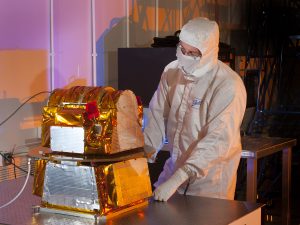Hacking. Satellites. Espionage. Disasters.
No, it is not the NSA, but rather the upcoming science-fiction film Geostorm. The film’s plot revolves around a network of satellites designed to control the earth’s weather, which (spoiler alert) does not exactly work as planned. While this technology might seem far-fetched or alarming, similar processes are quickly becoming a reality.
“Geoengineering,” also known as climate engineering or climate intervention, is moving from a niche, esoteric field into the international spotlight. Defined as a large-scale manipulation of the environment to alter the Earth’s climate, geoengineering may hold the solution to our pressing emissions and climate change problems. However, the novelty of the technology and its lack of substantive international attention leaves the future of geoengineering nebulous.
Down the Rabbit Hole
In 1992, the United Nations created the Kyoto Protocol as one of the first international agreements pledging reductions in greenhouse gas emissions. Although the Protocol mandated an average 5.2 percent reduction in greenhouse gas emissions by 2012, the international community never got close to this goal—partially because of the United States’ refusal to ratify the treaty. Almost two decades later, the United Nations tried to reduce emissions again, negotiating the Paris Climate Agreement in 2016. The goal of these accords is ambitious: maintain temperatures “well below 2°C above pre-industrial levels,” reduce greenhouse gas emissions, and transition the world from fossil fuels to renewable energy. However, limiting such temperature increases is a difficult task, especially because there is no scientific consensus about how much greenhouse gas emissions must be curbed to keep temperature changes below 2°C.

John Kerry at the United Nations Climate Change Conference, 2015.
It is unlikely that these efforts will be enough. “Climate change might hit, even with the Paris agreement in place, greater than 3 degrees celsius of warming by the end of the century. That’s a science fiction world we don’t want to end up in, ” cautioned Simon Nicholson, director of the Global Environmental Politics program at American University in an interview with the HPR. Even if we stopped producing greenhouse gases today, the earth would still continue to warm for at least 1,000 years. Slashing emissions by 70 percent right now would still lead to a 1°C increase in global temperatures and a 6-inch rise in sea level. Effects of global warming are already being seen across the world, from climate change refugees to species extinction, and the planet has long surpassed the symbolic milestone of 400 parts per million of atmospheric carbon dioxide. Inevitably, these problems will only get worse with time.
What-engineering?
Other than trying to reduce greenhouse gas emissions outright, another step humanity can take to combat climate change is manually changing earth’s reaction to our actions. Geoengineering provides that solution. The options geoengineering offers are wide-ranging, but mostly fall into two categories: solar radiation management and carbon dioxide removal. SRM involves increasing the earth’s reflectivity to bounce solar energy back into space, artificially preventing some of the sun’s rays from warming the earth. This could be done by spraying sulfate aerosols into the stratosphere, increasing the whiteness of marine clouds, or even sending reflective shields into space. On the other hand, CDR proposes to draw carbon dioxide from the air and funnel it into geologic reservoirs such as biomass or the ocean, which creates negative emissions. Though some scientists do not regard CDR as true climate engineering, its methods sound far more familiar, involving large-scale tree planting, fertilizing the ocean to encourage biomass growth, and speeding up the process of weathering rock to move carbon dioxide from the air to the soil.
“I wouldn’t mix [SRM and CDR]. They’re totally different things,” said Dan Schrag, director of the Harvard University Center for the Environment. Although CDR attacks the root cause of the issue—large carbon dioxide concentrations—Schrag explained that the process is “fundamentally slow in that it works on the same timescale of the carbon cycle.” Also, because the scale of the carbon dioxide problem is so large, CDR would be extremely costly to implement. Nicholson continued, “You’d need to plant something like ⅔ or more of the land area of India in new biomass just so you can start generating the bioenergy you need to start running [an effective CDR] system, which has extraordinary implications for water and land use.” Other environmental side effects, depending on the particular strategy in question, may include desertification, disruption of ocean food webs, or changing wind patterns.
SRM operates on a smaller timescale and budget than CDR, but mitigates the effects of climate change rather than stopping its causes. On a technological level, SRM is easier and cheaper. Ken Caldeira, a climate scientist at the Carnegie Institution for Science and a pioneering researcher in geoengineering, noted in an interview with the HPR that “there’s no fundamental technological barrier to doing [SRM]. It’s just getting particles into the stratosphere.” But SRM is not without its own share of associated harms. Diverting sunlight could cause altered rain patterns that lead to drought, acid rain and ocean acidification, or damage to the ozone layer. Also, the most realistic SRM option—injecting sulfate particles into the stratosphere—lasts only temporarily, and would have to be repeated on a weekly basis to have a sustained effect. A less defined and more radical technology than CDR, SRM in its current form runs potentially large risks.
With these risks and limitations taken into account, CDR and SRM nonetheless boast an impressive variety of benefits. Eliminating greenhouse gas emissions is critical to reducing climate change, but modifying our energy system to the degree necessary is near-impossible. Even if every country lived up to its pledge in the Paris Agreement, it is likely that temperatures would still rise above the 2°C goal. Thus, without forcibly removing carbon, which can only be done through CDR methods, the earth’s greenhouse gas concentration will quickly spiral out of control. Nicholson advocated for the use of CDR, stating, “models that kept the world beneath 2 degrees of warming by the end of the century depended by mid-century on large-scale removal of carbon from the atmosphere.” The drawbacks of CDR are primarily associated with its scale, but a slow implementation of CDR technologies could help mitigate these risks and allow the world to ease into its large-scale implementation in the long run.
As necessary as CDR might be in the long-term, it does little in the short-term to curb the effects of climate change. That is where SRM comes in: SRM encompasses the only known methods that could quickly and feasibly slow the rise in global temperatures, or even provoke global cooling if necessary. Caldeira confidently asserted that “every climate model simulation that’s been done with stratospheric aerosols has concluded that there would be less climate change in a high CO2 world with solar geoengineering than without solar geoengineering.” SRM will never be a definitive solution to global warming, but when or if the earth’s warming starts to spiral out of control, SRM could prove to be an invaluable asset.
We Need to Talk.
The international dialogue surrounding climate change has primarily developed without regard to geoengineering measures. Caldeira put it simply: “For most people, it’s not even on their radar.” Geoengineering is a new, relatively unexplored technology that can provoke a knee-jerk adverse reaction in politicians and civilians alike. After all, manipulating the earth just sounds scary. That is why geoengineering efforts have largely failed to obtain enough government funding, making it difficult for scientists to conduct research.

A NASA scientist prepares a radiant energy measurement instrument for launch, February 2017.
Politically-inclined environmentalists worry that geoengineering will induce a false sense of security, de-incentivizing the reduction of carbon dioxide emissions—the most important action needed to prevent climate change. In an interview with the HPR, Gernot Wagner, co-director of Harvard’s Solar Geoengineering Research Program, called this worry the moral hazard effect. However, he also pointed out the possibility of an “inverse moral hazard,” where awareness of geoengineering may encourage people to decrease emissions, much like awareness of drought risk forces people to be more conscious of their water usage.
Nonetheless, ignoring geoengineering on a political level is unsustainable, especially if the international community is truly committed to its goal of reducing emissions and preventing climate change. “Out of the Paris agreement, there’s talk about the potential for negative emissions and the need for carbon neutrality basically by mid-century, so the carbon dioxide removal conversation will be held under the Paris agreement,” asserted Nicholson. Using the structure of the United Nations Climate Change Conferences to discuss geoengineering is a natural progression of international dialogue. The framework is already in place to conduct research; organizations like the Intergovernmental Panel on Climate Change and the oversight of the United Nations will bring the results of that research to the political sphere.
However, Schrag warns against unnecessary regulation by the United Nations regarding geoengineering. “You want coordination, but you don’t necessarily want to bind people’s hands.” If global warming does accelerate to the point where immediate cooling of the climate is necessary, restrictive measures against geoengineering could prevent the international community from engaging in an effective response. Thus, a delicate balance must be found between allowing countries free rein on geoengineering tactics and complete prohibition of individual government action.
Without more public and international attention to geoengineering, its unknowns may prove more dangerous than any of its known risks. Wagner remarked that geoengineering may have a “free driver” problem, where the affordability and effectiveness of geoengineering may incentivize too many people to use it. But even one rogue country implementing a SRM strategy could affect the climate of the entire planet. Without an international framework to discuss, dissect, and research geoengineering, the international community would be unable to properly react to or regulate geoengineering endeavors that may have massive global ramifications.
As Schrag put it, “[Geoengineering] is not a fix. It’s a bandage, it’s a tourniquet … it’s not solving the underlying problem that has to be solved at some point.” However, in a world where greenhouse gas emissions seem to have no end and global temperatures continue to rise, geoengineering is a bandage that may ultimately prove necessary. Without research to fully understand the costs and benefits of geoengineering, and without the international community acknowledging geoengineering as a possible solution, the world loses a valuable asset in the fight against climate change. The potential of geoengineering to soften the impact of climate change is tremendous and has not received sufficient attention.
Perhaps geoengineering is simply inevitable. As Caldeira, echoing one of his colleagues, astutely observed, “When has humanity ever developed the ability to control its environment and then not exercised that control?” The world must quickly engineer a solution to the climate crisis, and geoengineering provides a possible answer.
Image credit: Flikr/NASA Goddard Space Flight Center // Flikr/WeMeanBusiness // CERES/JPSS-1 Pictures
